Buick LESABRE 2001 Owner Manual
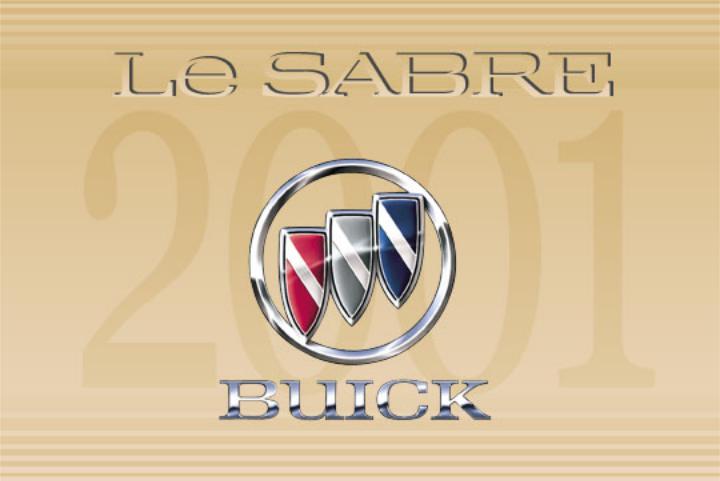
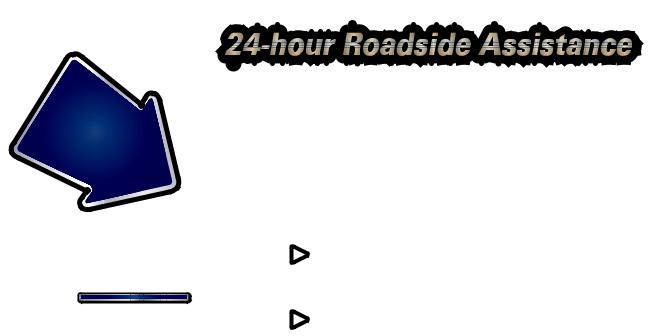
Every
2001 LeSabre under warranty is backed with the following
services:
Courtesy
Transportation
1-800-252-1112
(For vehicles purchased in Canada,
call 1-800-268-6800)
that provides in an emergency:
 Free lockout assistance
Free lockout assistance
 Free dead-battery assistance
Free dead-battery assistance
 Free out-of-fuel assistance
Free out-of-fuel assistance
 Free flat-tire change
Free flat-tire change
 Emergency towing
Emergency towing
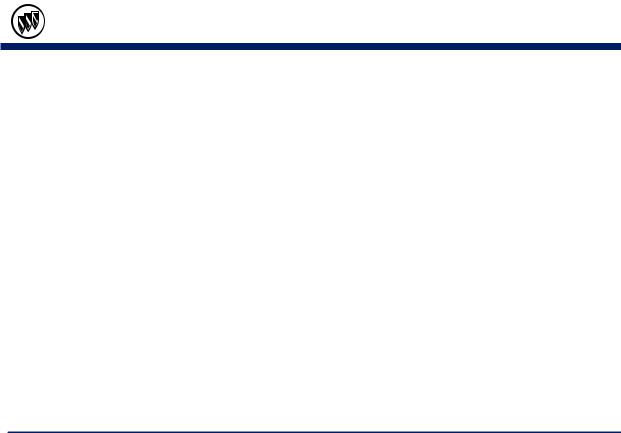
2001 Buick LeSabre
Owner's Manual
Litho in U.S.A. |
© Copyright General Motors Corporation 2000 |
Part Number 25711390 A First Edition |
All Rights Reserved |
i
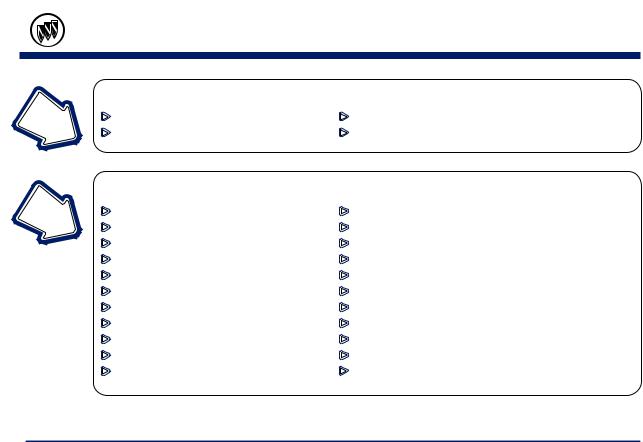
Table of Contents
Section 1
Section 2
ii
|
Seats and Restraint Systems |
Seats and Seat Controls |
Air Bag Systems |
Safety Belts |
Restraint Systems for Children |
|
Features and Controls |
Windows |
Mirrors |
Keys and Door Locks |
Storage Compartments |
Remote Keyless Entry System |
Convenience Net |
Trunk Release |
Auxiliary Power Outlets |
Automatic Transaxle |
OnStar® System (If Equipped) |
Parking Brake |
Sunroof (Option) |
Tilt Wheel |
HomeLink® Transmitter (If Equipped) |
Turn Signal/Multifunction Lever |
Instrument Panel, Warning Lights and Gages |
Windshield Wipers |
Driver Information Center (If Equipped) |
Cruise Control |
Personal Choice Features |
Exterior and Interior Lamps |
Head-Up Display (If Equipped) |
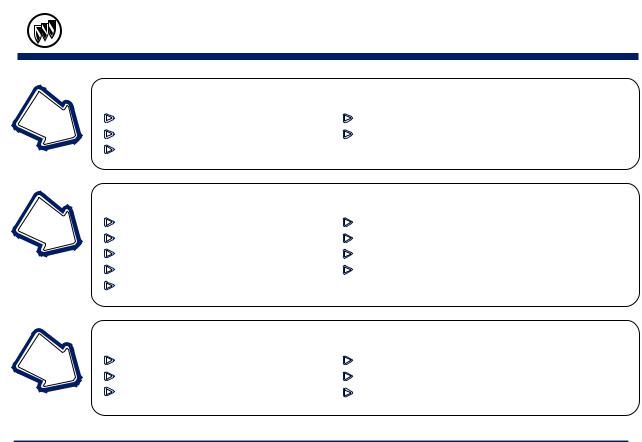
Table of Contents (cont'd)
Section 3
Section 4
Section 5
Comfort Controls and Audio Systems
Heating and Air Conditioning |
Radio Theft-Deterrent Feature |
Setting the Radio Clock |
Steering Wheel Controls (If Equipped) |
Radio/Cassette Player/CD Player |
|
|
Your Driving and the Road |
Defensive Driving |
Driving Tips for Various Road Conditions |
Drunken Driving |
Recreational Vehicle Towing |
Control of a Vehicle |
Loading Your Vehicle |
Braking |
Towing a Trailer |
Steering |
|
|
Problems on the Road |
Hazard Warning Flashers |
Engine Overheating |
Jump Starting |
Changing a Flat Tire |
Towing Your Vehicle |
If You're Stuck |
iii
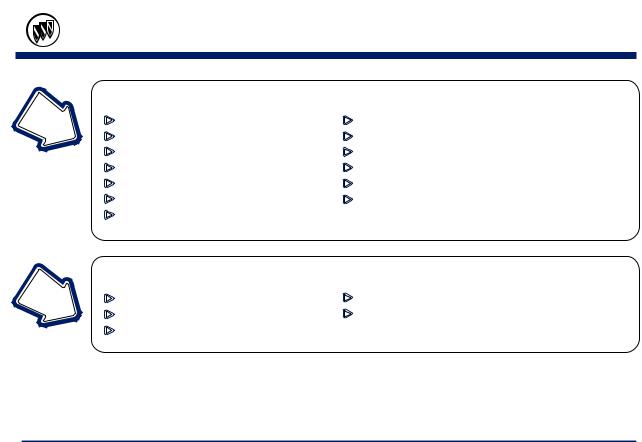
|
Table of Contents (cont'd) |
|
|
Service and Appearance Care |
|
Section 6 |
Fuel |
Windshield Wiper Blade Replacement |
|
Checking Fluids and Lubricants |
Tires and Wheels |
|
GM Oil Life System™ (If Equipped) |
Appearance Care |
|
Engine Air Cleaner/Filter |
Electrical System/Fuses and Circuit Breakers |
|
Passenger Compartment Air Filter (If Equipped) |
Capacities and Specifications |
|
Brakes |
Normal Maintenance Replacement Parts |
|
Bulb Replacement |
|
|
Maintenance Schedule |
|
Section 7 |
Scheduled Maintenance |
Recommended Fluids and Lubricants |
|
Owner Checks and Services |
Maintenance Records |
|
Periodic Maintenance Inspections |
|
iv

Table of Contents (cont'd)
Section 8
Section 9
Customer Assistance Information
Customer Satisfaction Procedures |
Warranty Information (See Warranty Manual) |
Customer Assistance Offices |
Reporting Safety Defects on page 8-9 |
Roadside Assistance and Courtesy Transportation |
Service Publications |
Index
In the Index you will find an alphabetical listing of almost every subject in this manual. You can use it to quickly find something you want to read.
Please refer to the last page of this manual for your Service Station Guide
v

GENERAL MOTORS, GM, the GM Emblem, BUICK, the BUICK Emblem and the name LESABRE are registered trademarks of General Motors Corporation.
This manual includes the latest information at the time it was printed. We reserve the right to make changes after that time without further notice. For vehicles first sold in Canada, substitute the name ªGeneral Motors of Canada Limitedº for Buick Motor Division whenever it appears in this manual.
Please keep this manual in your vehicle, so it will be there if you ever need it when you're on the road. If you sell the vehicle, please leave this manual in it so the new owner can use it.
We support voluntary technician certification.
For Canadian Owners Who Prefer a
French Language Manual:
Aux propriétaires canadiens: Vous pouvez vous procurer un exemplaire de ce guide en français chez votre concessionaire ou au:
Helm, Incorporated
P.O. Box 07130
Detroit, MI 48207
vi
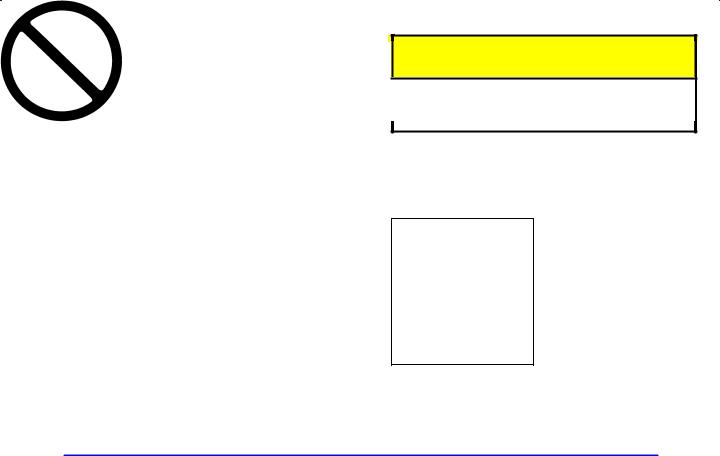
How to Use this Manual
Many people read their owner's manual from beginning to end when they first receive their new vehicle. If
you do this, it will help you learn about the features and controls for your vehicle. In this manual, you'll find that pictures and words work together to explain things quickly.
Safety Warnings and Symbols
You will find a number of safety cautions in this book. We use a box and the word CAUTION to tell you about things that could hurt you if you were to ignore the warning.
 CAUTION:
CAUTION:
These mean there is something that could hurt you or other people.
In the caution area, we tell you what the hazard is. Then we tell you what to do to help avoid or reduce the hazard. Please read these cautions. If you don't, you or others could be hurt.
You will also find a circle with a slash through it in this book. This safety symbol means ªDon't,º ªDon't do thisº or ªDon't let this happen.º
vii
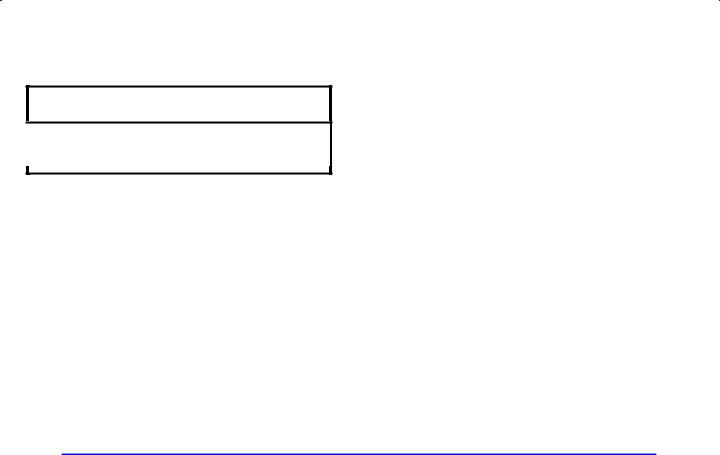
Vehicle Damage Warnings
Also, in this book you will find these notices:
NOTICE:
These mean there is something that could damage your vehicle.
In the notice area, we tell you about something that can damage your vehicle. Many times, this damage would not be covered by your warranty, and it could be costly. But the notice will tell you what to do to help avoid the damage.
When you read other manuals, you might see CAUTION and NOTICE warnings in different colors or in different words.
You'll also see warning labels on your vehicle. They use the same words, CAUTION or NOTICE.
viii
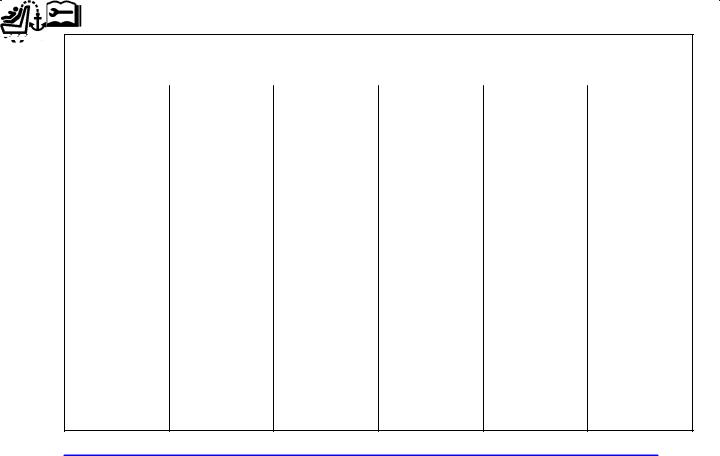
Vehicle Symbols
These are some of the symbols you may find on your vehicle. Also see ªWarning Lights and Gagesº in the Index.
For example, these symbols are used on an original battery:
CAUTION
POSSIBLE
INJURY
PROTECT
EYES BY
SHIELDING
CAUSTIC
BATTERY
ACID COULD
CAUSE
BURNS
AVOID
SPARKS OR
FLAMES
SPARK OR
FLAME
COULD
EXPLODE
BATTERY
These symbols are important for you and your passengers whenever your vehicle is driven:
CHILD
RESTRAINT
TOP STRAP
ANCHOR
DOOR LOCK
UNLOCK
FASTEN
SEAT
BELTS
POWER
WINDOW
AIR BAG
These symbols have to do with your lamps:
MASTER
LIGHTING
SWITCH
TURN
SIGNALS
PARKING
LAMPS
HAZARD
WARNING
FLASHER
DAYTIME
RUNNING
LAMPS
FOG LAMPS
These symbols are on some of your controls:
WINDSHIELD
WIPER
WINDSHIELD
WASHER
WINDSHIELD
DEFROSTER
REAR
WINDOW
DEFOGGER
VENTILATING FAN
These symbols are used on warning and indicator lights:
ENGINE
COOLANT
TEMP
BATTERY
CHARGING
SYSTEM
BRAKE
COOLANT
ENGINE OIL
PRESSURE
ANTI-LOCK
BRAKES
Here are some other symbols you may see:
FUSE
LIGHTER
HORN
FUEL
ix
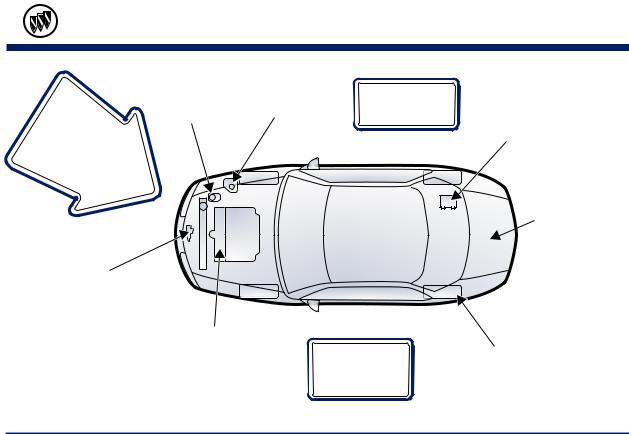
Service Station Guide
Windshield Washer
|
Fluid |
Cooling System |
Tire Pressure |
|
For |
See Section 5 |
|||
See Section 6 |
||||
See Section 6 |
||||
|
||||
a More |
|
|
|
|
Detailed Look at |
|
|
|
|
What's Under the Hood |
|
|
|
|
See Section 6 |
|
|
|
Hood Release
See Section 6
Engine Oil Dipstick
See Section 6 |
Oil Viscosity |
|
Engine Oil |
||
|
||
|
See Section 6 |
Battery
See Section 6
Spare Tire Pressure
See Section 5
Fuel
Use unleaded only.
See Section 6 for octane ratings.
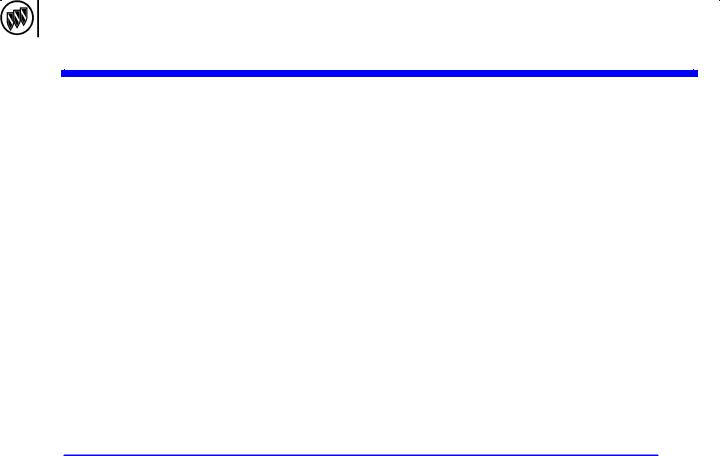
Section 1 Seats and Restraint Systems
Here you'll find information about the seats in your vehicle and how to use your safety belts properly. You can also learn about some things you should not do with air bags and safety belts.
1-2 |
Seats and Seat Controls |
|
1-30 |
Rear Seat Passengers |
|
||||
1-7 |
Safety Belts: They're for Everyone |
|
1-33 |
Rear Safety Belt Comfort Guides for |
1-12 |
Here Are Questions Many People Ask |
|
|
Children and Small Adults |
|
About Safety Belts -- and the Answers |
|
1-35 |
Children |
1-13 |
How to Wear Safety Belts Properly |
|
1-39 |
Restraint Systems for Children |
1-13 |
Driver Position |
|
1-50 |
Older Children |
1-19 |
Safety Belt Use During Pregnancy |
|
1-53 |
Safety Belt Extender |
1-20 |
Right Front Passenger Position |
|
1-53 |
Checking Your Restraint Systems |
1-20 |
Air Bag Systems |
|
1-53 |
Replacing Restraint System Parts |
1-28 |
Center Front Passenger Position |
|
|
After a Crash |
|
|
|
|
|
1-1
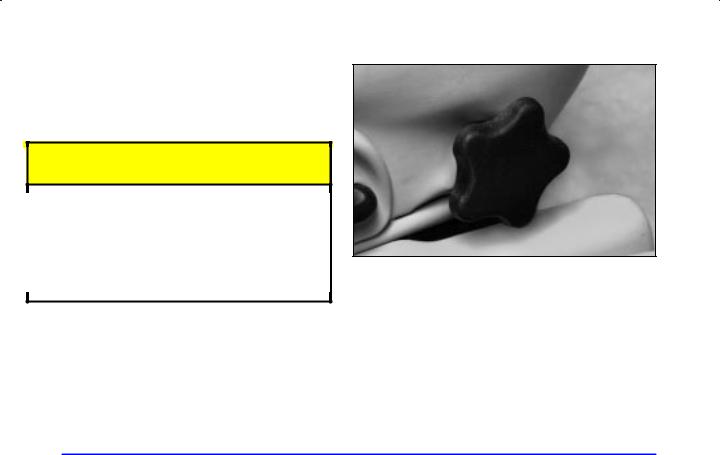
Seats and Seat Controls
This section tells you about the power seats -- how to adjust them and also about reclining seatbacks, lumbar adjustments, heated seats and head restraints.
Manual Front Seat
 CAUTION:
CAUTION:
You can lose control of the vehicle if you try to adjust a manual driver's seat while the vehicle is moving. The sudden movement could startle and confuse you, or make you push a pedal when you don't want to. Adjust the driver's seat only when the vehicle is not moving.
Pull up on the control bar located under the front of the seat to unlock it. Slide the seat to where you want it. Then release the bar and try to move the seat with your body to make sure the seat is locked into place.
Manual Lumbar Support
The knob that controls this feature is located on the outboard side of the seat. Turn the knob towards the front of the vehicle to increase lumbar support. Turn the knob towards the rear of the vehicle to decrease lumbar support.
1-2

Power Seats (If Equipped)
The power seat controls are located on the outboard side of each front seat cushion.
DRaise or lower the front of the seat cushion by holding the front part of the horizontal control up or down.
DRaise or lower the rear of the seat cushion by holding the rear part of the horizontal control up or down.
DRaise or lower the entire seat cushion by holding the whole horizontal control up or down.
DMove the seat forward or back by pushing the horizontal control to the front or back.
DPush the vertical control forward to bring the seat to a more upright position. Push it rearward to recline the seatback. See ªReclining Front Seatbacksº later in this section.
Power Lumbar Control (If Equipped)
The lumbar control is located on the outboard side of each front seat. Use the power seat control first to get the proper position. Then continue with the lumbar adjustment.
To reshape the lower seatback, press the lumbar control forward to increase support and rearward to decrease support. Press the control up or down to raise or lower the support mechanism.
Keep in mind that as your seating position changes, as it may during long trips, so should the position of your lumbar support. Adjust the seat as needed.
1-3
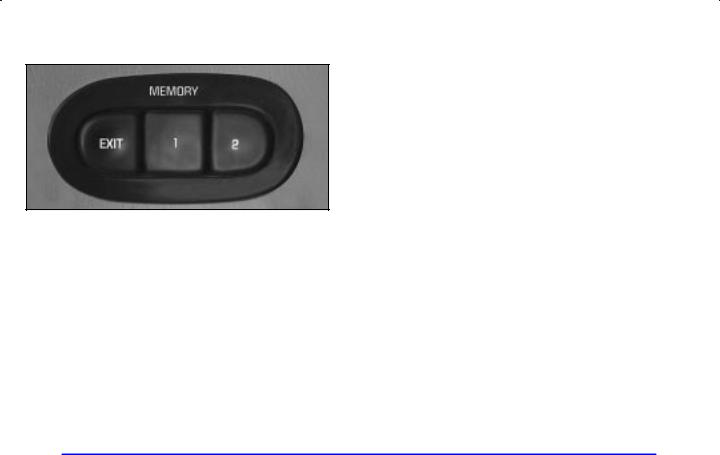
Memory Seat and Mirrors (If Equipped)
If your vehicle has this feature, the controls on the driver's door panel are used to program and recall previous settings.
You can use this feature to save your driver's seat position, lumbar adjustment, outside mirror positions, personalization features, comfort controls and radio settings.
Adjust the driver's seat (including the lumbar adjustments) and both outside mirrors to the position you would like for driving. Then press and hold memory button 1 for more than three seconds. A double beep will sound when the memory is set.
To set the seat and mirror positions for a second driver, follow the previous steps, but press button 2 instead.
You can also store an exit position for each driver. The exit position is programmed by moving the seat to
the desired exit position and then holding the exit button for more than three seconds. The exit position set will be for the most recently selected driving position (1 or 2).
Please note that mirror and lumbar positions will not be stored or recalled for the exit position.
To recall your memory positions, your vehicle must be in PARK (P). Push and release the memory button (1 or 2) corresponding to the desired driving position. The seat and mirrors will move to the position previously stored for the identified driver. You will hear one beep.
To recall the exit position, your vehicle must be in PARK (P). Push and release the EXIT button and the seat will move to the exit position previously stored for the current identified driver. You will hear one beep.
If an exit position has not been stored for the current identified driver, the seat will move all the way back.
To stop recall movement of the seat at any time, press the driver's power seat control located on the outboard side of the front seat.
If you would like your stored driving or exit position to be recalled when unlocking your vehicle with the transmitter, see ªDIC Personal Choice Programmingº in the Index.
1-4
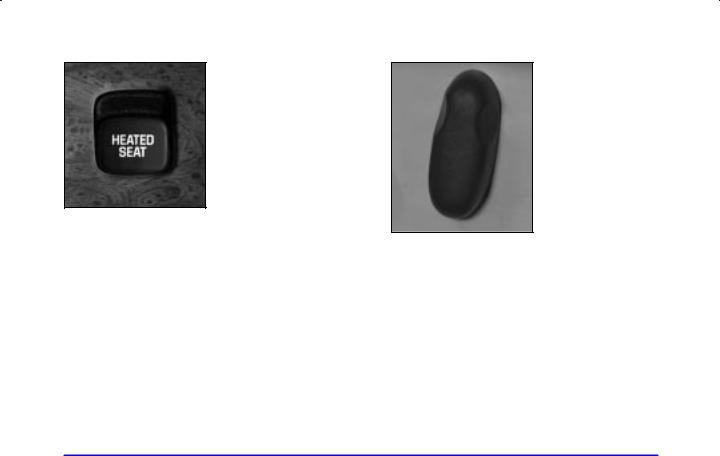
Heated Seats (Option) |
Reclining Front Seatbacks |
The heated seat controls are located on the driver's and front passenger's door panel.
Push the button once for a high setting, twice for a low setting, and a third time to turn off the heated seat. The LO setting warms the seatback and cushion until the seat approximates body temperature. The HI setting heats the seat to a slightly higher temperature.
The heated seats can only be used when the ignition is turned on. The heating elements in the seats automatically turn off when the vehicle's ignition is turned off.
The vertical control described previously in this section reclines the front seatbacks.
If your vehicle has the manual recliner, lift the lever on the outboard side of the seat and move the seatback to the desired position. Release the lever to lock the seatback. Pull up on the lever and the seat will go to an upright position.
1-5
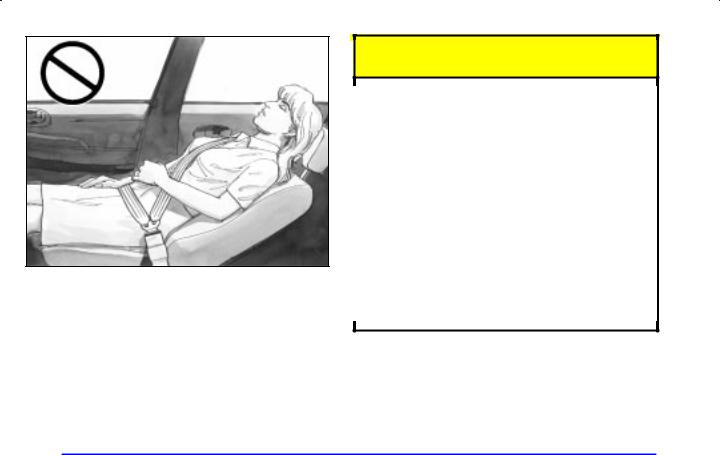
But don't have a seatback reclined if your vehicle is moving.
 CAUTION:
CAUTION:
Sitting in a reclined position when your vehicle is in motion can be dangerous. Even if you buckle up, your safety belts can't do their job when you're reclined like this.
The shoulder belt can't do its job. In a crash you could go into it, receiving neck or other injuries.
The lap belt can't do its job either. In a crash the belt could go up over your abdomen. The belt forces would be there, not at your pelvic bones. This could cause serious internal injuries.
For proper protection when the vehicle is in motion, have the seatback upright.
Then sit well back in the seat and wear your safety belt properly.
1-6
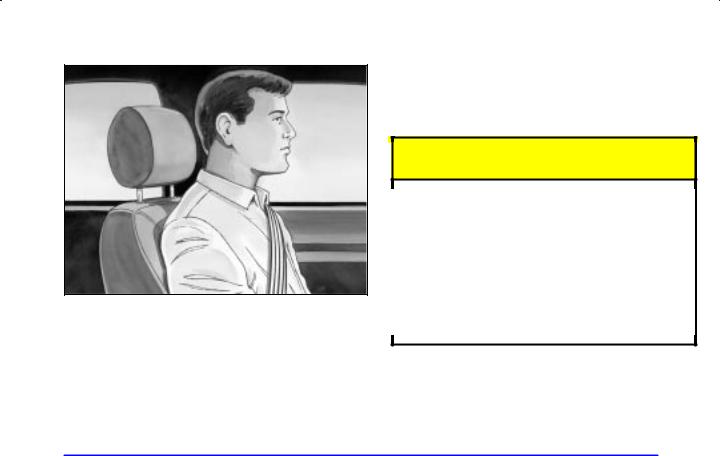
Head Restraints
Slide the head restraint up or down so that the top of the restraint is closest to the top of your ears. This position reduces the chance of a neck injury in a crash.
Safety Belts: They're for Everyone
This part of the manual tells you how to use safety belts properly. It also tells you some things you should not do with safety belts.
And it explains the air bag system.
 CAUTION:
CAUTION:
Don't let anyone ride where he or she can't wear a safety belt properly. If you are in a crash and you're not wearing a safety belt, your injuries can be much worse. You can hit things inside the vehicle or be ejected from it. You can be seriously injured or killed. In the same crash, you might not be if you are buckled up. Always fasten your safety belt, and check that your passengers' belts are fastened properly too.
1-7
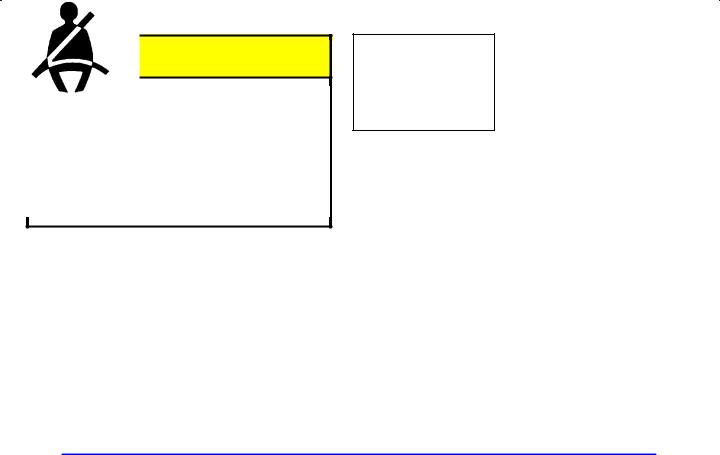
 CAUTION:
CAUTION:
It is extremely dangerous to ride in a cargo area, inside or outside of a vehicle. In a collision, people riding in these areas are more likely to be seriously injured or killed. Do not allow people to ride in any area of your vehicle that is not equipped with seats and safety belts. Be sure everyone in your vehicle is in a seat and using a safety belt properly.
Your vehicle has a light that comes on as a reminder to buckle up. See ªSafety Belt Reminder Lightº in the Index.
In most states and Canadian provinces, the law says to wear safety belts. Here's why: They work.
You never know if you'll be in a crash. If you do have a crash, you don't know if it will be a bad one.
A few crashes are mild, and some crashes can be so serious that even buckled up a person wouldn't survive. But most crashes are in between. In many of them, people who buckle up can survive and sometimes walk away. Without belts they could have been badly hurt
or killed.
After more than 30 years of safety belts in vehicles, the facts are clear. In most crashes buckling up does matter ... a lot!
1-8
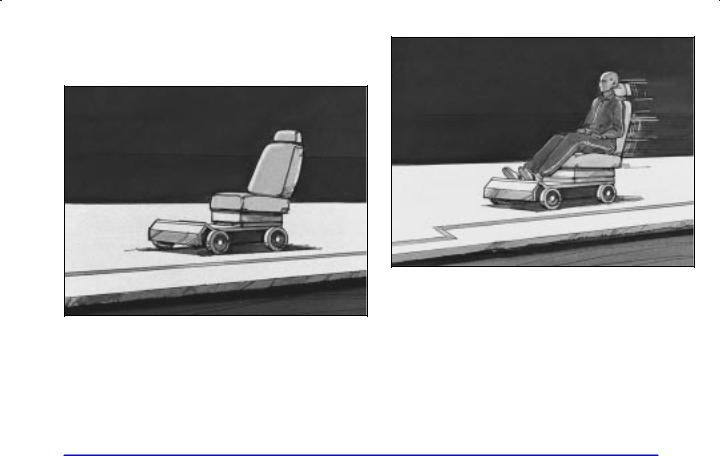
Why Safety Belts Work
When you ride in or on anything, you go as fast as it goes.
Put someone on it.
Take the simplest vehicle. Suppose it's just a seat on wheels.
1-9

Get it up to speed. Then stop the vehicle. The rider doesn't stop.
The person keeps going until stopped by something.
In a real vehicle, it could be the windshield ...
1-10
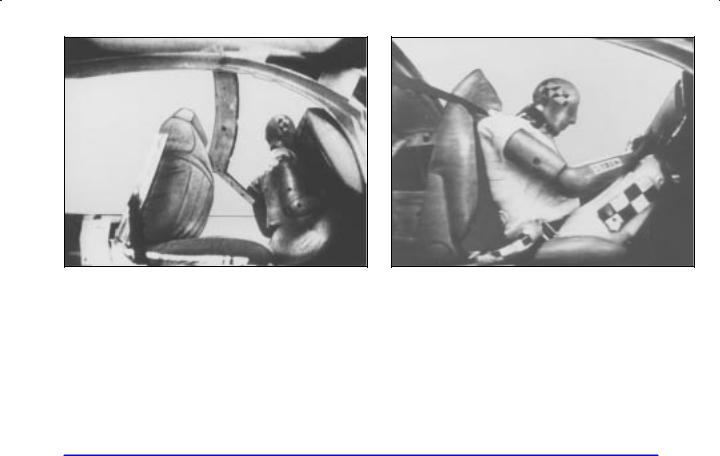
or the instrument panel ... |
or the safety belts! |
|
With safety belts, you slow down as the vehicle does. |
|
You get more time to stop. You stop over more distance, |
|
and your strongest bones take the forces. That's why |
|
safety belts make such good sense. |
1-11

Here Are Questions Many People Ask About Safety Belts -- and the Answers
Q: Won't I be trapped in the vehicle after an accident if I'm wearing a safety belt?
A: You could be -- whether you're wearing a safety belt or not. But you can unbuckle a safety belt, even if you're upside down. And your chance of being conscious during and after an accident, so you can unbuckle and get out, is much greater
if you are belted.
Q: If my vehicle has air bags, why should I have to wear safety belts?
A: Air bags are in many vehicles today and will be in most of them in the future. But they are supplemental systems only; so they work with
safety belts -- not instead of them. Every air bag system ever offered for sale has required the use of safety belts. Even if you're in a vehicle that has air bags, you still have to buckle up to get the most protection. That's true not only in frontal collisions, but especially in side and other collisions.
Q: If I'm a good driver, and I never drive far from home, why should I wear safety belts?
A: You may be an excellent driver, but if you're in an accident -- even one that isn't your fault -- you and your passengers can be hurt. Being a good driver doesn't protect you from things beyond your control, such as bad drivers.
Most accidents occur within 25 miles (40 km) of home. And the greatest number of serious injuries and deaths occur at speeds of less
than 40 mph (65 km/h).
Safety belts are for everyone.
1-12
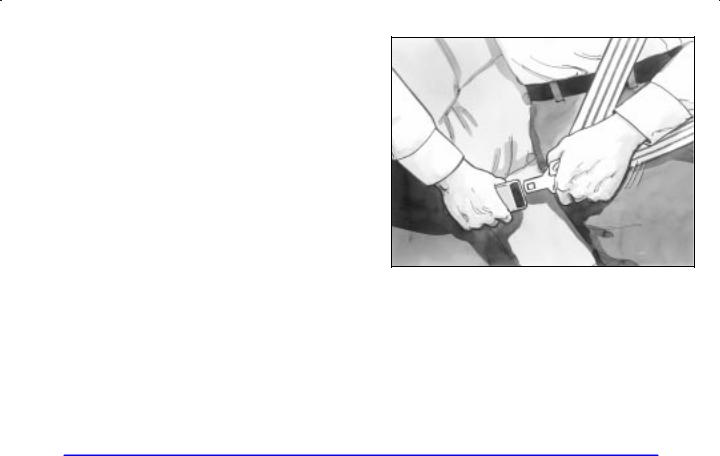
How to Wear Safety Belts Properly
Adults
This part is only for people of adult size.
Be aware that there are special things to know about safety belts and children. And there are different rules for smaller children and babies. If a child will be riding in your vehicle, see the part of this manual called ªChildren.º Follow those rules for everyone's protection.
First, you'll want to know which restraint systems your vehicle has.
We'll start with the driver position.
Driver Position
This part describes the driver's restraint system.
Lap-Shoulder Belt
The driver has a lap-shoulder belt. Here's how to wear it properly.
1.Close and lock the door.
2.Adjust the seat so you can sit up straight. To see how, see ªSeatsº in the Index.
3.Pick up the latch plate and pull the belt across you. Don't let it get twisted.
The lap-shoulder belt may lock if you pull the belt across you very quickly. If this happens, let the belt go back slightly to unlock it. Then pull the belt across you more slowly.
1-13
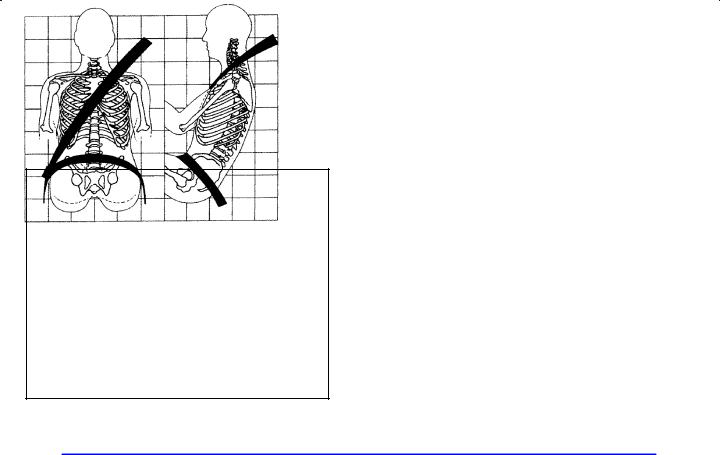
4.Push the latch plate into the buckle until it clicks.
Pull up on the latch plate to make sure it is secure. If the belt isn't long enough, see ªSafety Belt Extenderº at the end of this section.
Make sure the release button on the buckle is positioned so you would be able to unbuckle the safety belt quickly if you ever had to.
The lap part of the belt should be worn low and snug on the hips, just touching the thighs. In a crash, this applies force to the strong pelvic bones. And you'd be less likely to slide under the lap belt. If you slid under it, the belt would apply force at your abdomen. This could cause serious or even fatal injuries. The shoulder belt should go over the shoulder and across the chest.
These parts of the body are best able to take belt restraining forces.
The safety belt locks if there's a sudden stop or crash, or if you pull the belt very quickly out of the retractor.
1-14
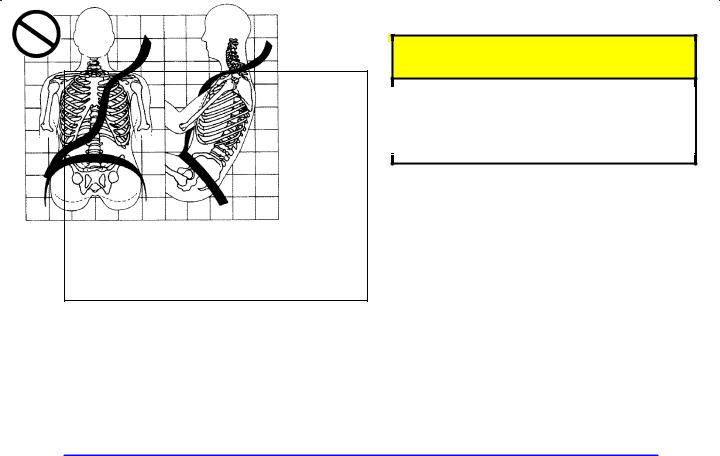
Q: What's wrong with this?
A: The shoulder belt is too loose. It won't give nearly as much protection this way.
 CAUTION:
CAUTION:
You can be seriously hurt if your shoulder belt is too loose. In a crash, you would move forward too much, which could increase injury. The shoulder belt should fit against your body.
1-15
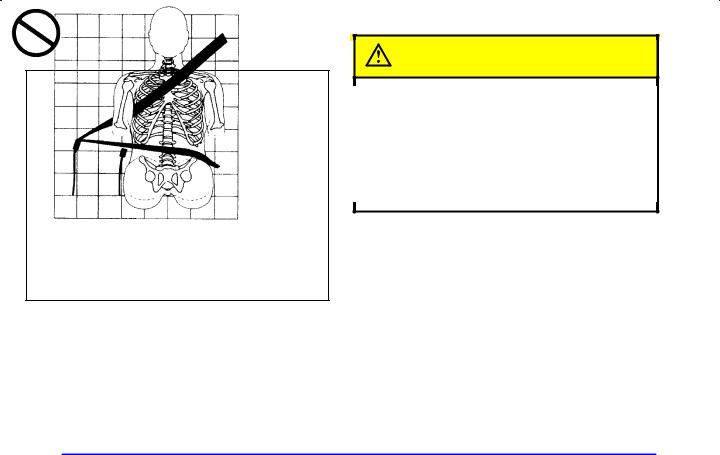
Q: What's wrong with this?
CAUTION:
You can be seriously injured if your belt is buckled in the wrong place like this. In a crash, the belt would go up over your abdomen. The belt forces would be there, not at the pelvic bones. This could cause serious internal injuries. Always buckle your belt into the buckle
nearest you.
A: The belt is buckled in the wrong place.
1-16
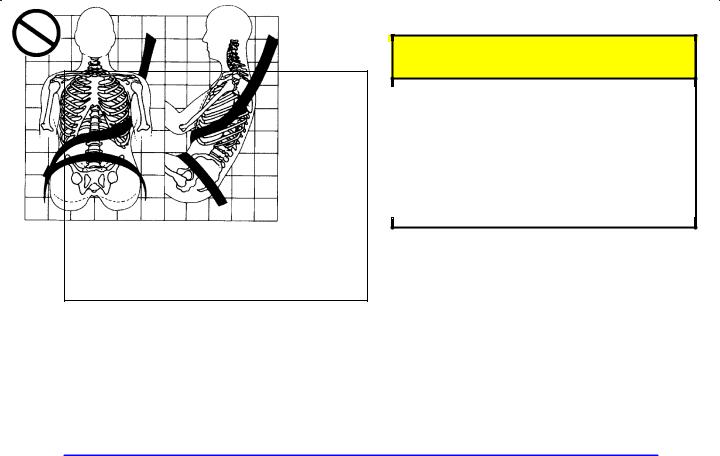
Q: What's wrong with this?
A: The shoulder belt is worn under the arm. It should be worn over the shoulder at all times.
 CAUTION:
CAUTION:
You can be seriously injured if you wear the shoulder belt under your arm. In a crash, your body would move too far forward, which would increase the chance of head and neck injury. Also, the belt would apply too much force to the ribs, which aren't as strong as shoulder bones. You could also severely injure internal organs like your liver or spleen.
1-17
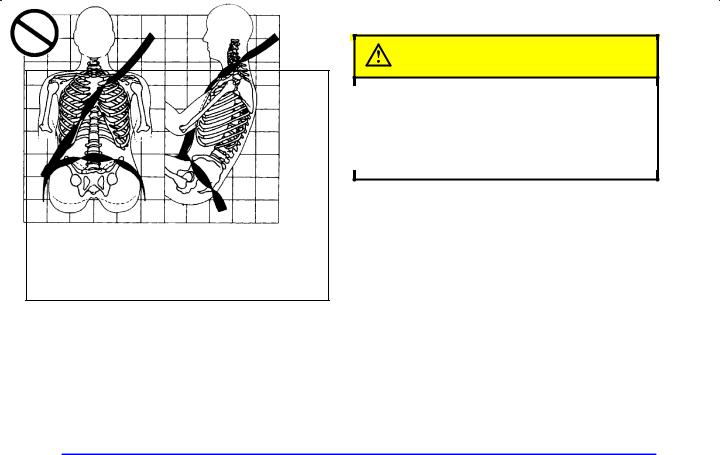
Q: What's wrong with this?
CAUTION:
You can be seriously injured by a twisted belt. In a crash, you wouldn't have the full width of the belt to spread impact forces. If a belt is twisted, make it straight so it can work properly, or ask your dealer to fix it.
A: The belt is twisted across the body.
1-18
